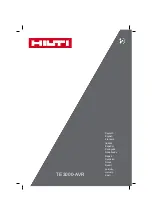
8
tool will draw. An undersized cord will
cause a drop in line voltage, which
will result in a loss of power and
overheating.
3. The below table shows the correct
size to use according to cord length
and the amperage rating that is listed
on the tool’s nameplate.
4. When in doubt, use the next heavier
gauge. The smaller the gauge number,
the heavier the cord.
5. Verify that the extension cord is
properly wired and in good condition.
Replace a damaged extension cord
immediately, or have it repaired by a
qualified electrician before using it.
Keep the extension cord away from
sharp objects, excessive heat, and
damp or wet areas.
6. Use a separate electrical circuit for
power tools. This circuit must consist
of not less than 14 gauge wire, and
should be protected by either a 15 Amp
time-delayed fuse or a circuit breaker.
Before connecting the power tool to
the outlet, verify that the switch is in
the OFF position, and that the voltage
of the power source is the same as the
voltage that is indicated on the tool’s
nameplate. Running this Heat Gun at
lower voltage will damage the motor.
25'
50'
100'
150'
(7.5 m)
(15 m)
(30 m)
(45 m)
0
6
18
16
16
14
6
10
18
16
14
12
10
12
16
16
14
12
12
16
14
12
Not Applicable
Total length
Amperage rating
More than
Not more
than
MINIMUM GAUGE (AWG) EXTENSION CORDS
(120 V use only)
HEAT GUN APPLICATIONS
The Heat Gun is a tool that can be used
for many different applications. As with
any power tool, there are many factors
that will affect its effectiveness and
safety. It is important to be aware of
these factors before you begin to use
the tool. The chart below illustrates
examples of several Heat Gun
applications and the ideal temperature
settings.
Heating applications are affected
by several factors. The density of
the material being heated, ambient
temperature, wind, distance between
the nozzle and the surface being
heated and the heating technique will
affect the speed at which the surface
will be hsated. It is always safer to start
heating the surface with the Heat Gun
temperature set to LOW. Using the
aoove chart, increase the temperature
setting to HIGH for those applications
requiring additional heat.
During the heating process, it is very
important to maintain a consistent
distance between the nozzle and the
surface being heated.
NOTE: The nozzle must be at least
2” (25 mm) from the surface being
heated to permit adequate air flow and
to prevent overheating.
Always keep the Heat Gun in motion
during the hsating process. Inadequate
motion will result in overheating and
possible damage to the surface or to
the Heat Gun.
Summary of Contents for PRO-PC1200
Page 1: ...Heat Gun User s Manual Model No PRO PC1200 English 2 I Espa ol 14...
Page 14: ...NOTES...
Page 15: ...NOTES...
Page 16: ...www promakertools com...
Page 17: ...Pistola de Calor Manual del Usuario Modelo No PRO PC1200...
Page 31: ...NOTAS...
Page 32: ...www promakertools com...









































